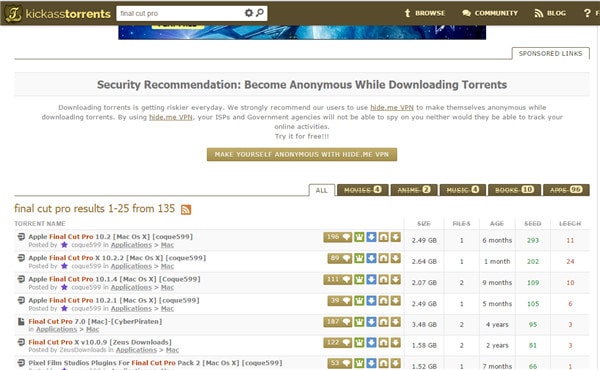NTFS-3G is a stable, full-featured, read-write NTFS driver for Linux, Android, Mac OS X, FreeBSD, NetBSD, OpenSolaris, QNX, Haiku, and other operating systems. It provides safe handling of the Windows XP, Windows Server 2003, Windows 2000, Windows Vista, Windows Server 2008, Windows 7, Windows 8 and Windows 10 NTFS file systems.
- For Mac Os X Mavericks Full Get Yosemite Torrent Index Social Services
- For Mac Os X Mavericks Full Get Yosemite Torrent Index Social Security
A alternative, called Tuxera NTFS is available for. The release notes and the software changes can be found on the page. Subscribe for new release notifications.

Download The latest stable version is, released on March 28, 2017. Availability: (fastest) Installation Linux: Most distributions include and use NTFS-3G by default. Please use that one unless it’s an. If you wish to install NTFS-3G from the source code then make sure you have installed the basic development tools (gcc compiler, libc-dev libraries). Then type:./configure make make install # or ' sudo make install' if you aren't root Non-Linux: Please see the OS specific installation and source packages above. Usage If there was no error during installation then the NTFS volume can be mounted in read-write mode for everybody as follows. Unmount the volume if it had already been mounted, replace /dev/sda1 and /mnt/windows, if needed.
Mount -t ntfs-3g /dev/sda1 /mnt/windows Please see the for more options and examples. You can also make NTFS to be mounted during boot by adding the following line to the end of the /etc/fstab file: /dev/sda1 /mnt/windows ntfs-3g defaults 0 0. The major and important driver changes are listed below. Stable releases are GREEN, releases for testing are RED. While the NTFS-3G project globally aims at providing a stable NTFS driver for several operating systems such as Linux, FreeBSD, Mac OS X, Solaris etc., the advanced branch specifically aims at developing, maturing, and releasing features to get user feedback before they are integrated into the main branch. The advanced releases are designed as add-ons to the latest stable release, so they benefit from all the improvements and fixes integrated in the main branch. This facilitates the subsequent integration of newer features both for the developer and the user. The documentation on the features which were developed as part of former advanced versions is available here, and updated to reflect the latest versions:.

For Mac Os X Mavericks Full Get Yosemite Torrent Index Social Services
File ownership and permissions: the of files, implemented according to POSIX rules, are interoperable with Windows. POSIX ACLs: the ACLs, are an extension to, as defined in a POSIX draft. Junction points: the created by Windows are seen as symbolic links. Access to NTFS Internal data: a few useful internal data are mapped to for easier access. Compression: are supported.
Tools for managing ownership, permissions and ACLs: checks the integrity of ownership, permissions and ACL, gives help to configure ownership. Downloads The available packages are extensions to recent stable versions. They pass, they have been tested on top of i386 and x8664 (small-endian) and M68K (big-endian) CPUs, and their interoperability has been tested against Windows (XP and later versions.) Nevertheless problems may have crept in, so you should backup your valuable data regularly. OpenIndiana users: please see 2015.3.14AR.2 release source tarball Fedora 21 RPM for i386 Fedora 21 RPM for x8664 Executable for Knoppix 5.1.1 2015.3.14AR.1 release source tarball Fedora 21 RPM for i386 Fedora 21 RPM for x8664 Executable for Knoppix 5.1.1 Global Changelog Miscellaneous tools for NTFS md5 for integrity checks To install these versions, for a base version. To benefit from some features, you may have to define options at mount time and insert configuration files in the directory.NTFS-3G of the NTFS partition. See the relevant pages for details. The version for Knoppix is a prelinked one which only uses legacy interfaces, so that it can be run on most Linux systems without being installed.
Technically, Kernel Panic is a kind of emergency procedure that the operating system enables when it comes across a system error from which it cannot safely recover. Specifically, the OS will shut down automatically, and to use the computer again you’ll have to restart it manually. Kernel Panic is very rare, and isn’t necessarily a symptom of a major problem. It can also be caused, for example, by a malfunction of a defective data package. So, our first tip: if you only get one KP and, after the reboot, it doesn’t happen again (or at least it doesn’t happen again for a long time) and everything seems to work normally, then you can relax and ignore what happened.
If the Kernel Panic starts to become more frequent (for example, a couple every month), you should identify the problem and fix it. In this article, we’ll tackle the problem from a software point of view, but remember that sometimes the KP could have been caused by hardware. What can cause Kernel Panic? The most common cause is a hardware failure – either the Mac itself, or an external device or application.
Some of these problems are only tem porary and will disappear after a reboot, as we have already mentioned. Others are more complicated, and will stop you using your computer. Badly-written drivers or plugins could cause a KP or even the random presence of specific conditions. In these cases, the Mac should work properly again after the reboot. There are other, more complex problems that need to be identified and fixed. Let’s start with the ones that are easier to spot.
How to recognize Kernel Panic The easiest symptom to recognize is the classic screen with the start button image in the background, and the multilingual message that tells you: “ You need to restart your computer.” Sometimes, however, you don’t get this default message, and your Mac could spontaneously restart, turn off, or stop responding to commands, forcing you to shut down the computer forcibly. In these cases, to be certain that it was a Kernel Panic, just go to /Library/Logs/DiagnosticReports (in Mavericks). There, if the problem was really a KP, you’ll find a log with the details of the incident. Sometimes, however, this file could be missing, even if it was a Kernel Panic. In this case (even though it’s hard to tell), the problem is probably in your Mac’s hardware, such as a faulty RAM or hard drive. We’ll see later how to deal with the problem if that’s the case.
When applications fail Sometimes a badly-written program could be behind a Kernel Panic. OS X 10.8 onwards, after a reboot your Mac will automatically give you the choice to open the programs that you were using just before the KP. The best thing to do is to say yes, clicking on Open. If one of the applications is the cause of the Kernel Panic, it will occur again. If the computer crashes again, now you know you shouldn’t open those applications in the second reboot. Instead, reopen the applications one by one until you find the one that’s behind the KP.
Uninstall it and the problem should be resolved. Keep your system updated By keeping your OS, programs and firmware up-to-date, you’ll decrease the likelihood of conflict and therefore of a Kernel Panic. Open Software Updates in the Apple Update menu and update all programs (operating system, firmware and software downloaded the Mac App Store). Check that the versions of the programs you downloaded from the store are the most recent. You can, for example, check the, or use the built-in function in the applications, if they have one. Sometimes it’s a startup issue To check if startup items are responsible for the Kernel Panic, follow these steps:.
Disable all the login items ( System Preferences Users and Groups, then select your user, go to the Login Items tab, select all the items and click on the ‘minus’ sign). Restart your Mac in Safe Boot Mode (hold down the Shift key during startup). Now you need to disable all login items for all accounts and groups, using the same method described above. Satellite m55 s325 drivers for mac os. Some applications install items that start automatically with the operating system, before you even log in. You must also disable those. To do this, go to Library/StartupItems.

There you’ll find folders with the names of applications. Select them all and drag them into any other folder (you’ll need the administrator password). When the Kernel Panic problem is solved you can put them back into the same folder. Now you can restart your Mac.
For Mac Os X Mavericks Full Get Yosemite Torrent Index Social Security
If there’s no Kernel Panic this time, then one of the login or startup items was responsible for it. Put the items back into the folder one by one, restarting the computer each time, until you find the cause. Find the drivers that your Mac doesn’t like If you recently installed drivers, for example for a new printer, and as soon as you tried to use it you got a Kernel Panic, it could be the printer’s fault: incorrect drivers can make your OS crash. Check carefully that you have the latest drivers for that specific device (and not a similar model), and that they are compatible with your OS X version. If you don’t know what version you are using, go to the Apple menu in the upper left corner and click on About This Mac. Kernel Panic can also be caused by the hardware itself, which for some reason your Mac doesn’t like.
If you’re sure that the installed drivers are the right ones, and every time you turn on the device your system crashes, the only solution is to stop using it. Get your hard disk in shape The hard disk must have free space and be in good condition. To do this, get rid of things you don’t need or use. We all have files that are no longer useful or applications we never use.
You can use, which creates an index of all the contents on your Mac and sorts them according to their size. This will help you find files that are heavy but useless, and could free up space equal to about 5 times the amount of RAM installed, giving your computer a little room to breathe. Something else you can do is a little hard disk maintenance. To do so, start the Mac from the OS installation disk (insert the DVD into the drive and restart your Mac while holding the C key) or the recovery partition for OS Lion (restart while holding down Command and R). Now run Disk Utility Applications Utilities Disk Utility, select the HD in the left column and just click on Repair Disk.
Nothing works? Reinstall OS X If you’ve tried everything and nothing seems to work, try reinstalling the operating system.